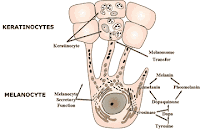My Favourite Tissue - The Umbilical Cord
Basic Anatomy and Function
The umbilical cord is what connects the developing fetus during pregnancy
to the placenta, which passes nutrients and other materials
between the mother and the fetus. Also, the fetus cannot breathe, therefore it provides the fetus with the oxygen it needs[2]. The umbilical cord is made up of two arteries and one vein. The arteries carry blood from the fetus to the placenta and the vein carries blood back to the fetus. The arteries and veins are protected by a substance called Wharton's Jelly [1]. It is usually 1 inch in diameter and 23 inches in length and is coiled in a counterclockwise direction[1]. The origin of the umbilical cord is comprised of the yolk sac and
allantosis[2]. Figure 1: Umbilical cord
Figure 2: Developing fetus in the uterus
Figure 3: Anatomy of Umbilical Cord
Development of the Umbilical Cord
Between the 4th and 8th week of pregnancy, the amnion envelopes the body stalk, ductus omphalo-entericus and the umbilical coelom. The amniotic cavity then surrounds the connecting stalk plus the embryo and presses the stalk into a tube-like structure that is covered in epithelium, connecting the developing embryo to the placenta. Eventually, all structures are lost except for the vein and arteries which are embedded in Wharton's Jelly[3].
Figure 4: Development of cord
Histology

The umbilical cord is composed of
different types of epithelium throughout. Near the navel is composed of unkeratinized, stratified squamous epithelium, which provides the transition
from abdominal wall to the cord surface. Further away from the navel, it is composed of 2-8 layers of stratified columnar epithelium and also simple columnar epithelium[4].
Wharton's Jelly is composed of mucous connective tissue. Fibroblasts are the most prominent cell type in connective tissue, which secretes the fibers, composing
the extracellular matrix. These include collagen, elastic and reticular fibers and carbohydrate components,
such as GAG's[5].
 Figure 5: Cross section of umbilical cord
Figure 6: Fibroblasts in connective tissue
Figure 5: Cross section of umbilical cord
Figure 6: Fibroblasts in connective tissue
Pathology
Decreased length: An umbilical cord is considered short when it is 40 cm or less. A short umbilical cord is associated with fetal movement disorders, placental abruption and cord rupture, all which are to fatal to the fetus[6].
Increased Length: An umbilical cord is considered long when it is 70 cm or more. A long umbilical cord could cause fetal entanglement, true knots and thombi. A long cord has been found to be associated with increased brain abnormalities. The cord can wrap around the babies neck and cut off the oxygen supply to the brain. This is more common in males and occurs in 20-33% of pregnancies[6].
Knots: True knots occur in 1% of pregnancies and are usually caused by older maternal age and increased cord length. True knots are associated with higher intrauterine death than those with normal cords. False knots are caused by an excessive amount of localized Wharton's Jelly and are not clinically significant[6].
Figure 7: False knot (top) and true knot (bottom)
Cord Stricture: This is a constriction of the umbilical cord and occurs in 19% of fetal deaths, as most are stillborn. They are caused by a deficiency in Wharton's jelly and there may be evidence that cord strictures could be genetic[7].
Hematoma: An umbilical hematoma is extravasation of blood into the Wharton's jelly surrounding the blood vessels. They can occur spontaneously and can be associated with cord cysts. Hematoma's are responsible for 50% of fetal mortality[7].
Cysts: An umbilical cord cyst can be a true or false cyst and occur in 0.4% of pregnancies. True cysts are caused by remnants of early embryonic structures. False cysts are fluid-filled sacs that are related to swelling in the Wharton's jelly. Some cysts can be associated with birth defects, such as chromosomal abnormalities and kidney defects[7].
Figure 8: Umbilical cyst
Interesting Facts
- The umbilical cord contains hematopoietic stem cells, which can become specialized cells to help treat leukaemia, lymphoma and other diseases!
- Babies will touch and play with their umbilical cord while in utero and will even suck on it
References
Herer, Elaine and Blott, Maggie. (2009). Pregnancy Day by Day. Retrieved from
http://pregnancy.familyeducation.com/prenatal-health-and-nutrition/fetal-growth-and-development/66161.html [1]
Cloe, Adam. (2013). What are 3 Functions of the Umbilical Cord?. Retrieved from
http://www.ehow.com/about_4672809_what-functions-umbilical-cord.html [2]
Life Map. (2012). Embryonic Development. Retrieved from http://discovery.lifemapsc.com/in-vivo-development/umbilical-cord [3]
Baergen, Rebecca., Benirschke, Kurt and Kaufmann, Peter. (2006). Pathology of the human
placenta, 5th edition. Springer New York. pp 380-451 [4]
Volkoff, Helene. (2013). Histology: Connective Tissue. (Power Point slides). [5]
Beall, Marie. (2012). Umbilical Cord Complications. Retrieved from http://emedicine.medscape.com/article/262470-overview#aw2aab6b3[6]
March of Dimes. (2013). Umbilical Cord abnormalities. Retrieved from http://www.marchofdimes.com/pregnancy/umbilical-cord-abnormalities.aspx[7]
Images:
1. http://library.med.utah.edu/WebPath/PLACHTML/PLAC012.html
2. http://m.medlineplus.gov/ency/presentations/100196.htm
3. http://misskalypso.wordpress.com/2011/05/05/cord-around-the-neck-no-worries/
4. http://radioguraphics.net/tt?page=4
5.http://lecannabiculteur.free.fr/SITES/UNIV%20W.AUSTRALIA/mb140/CorePages/Connective/Connect.htm
6. http://www.vetmed.vt.edu/education/curriculum/vm8054/Labs/Lab5/Lab5.htm
7. http://www.jacknaimsnotes.com/2011/09/false-vs-true-umbilical-cord-knot.html
8. http://newborns.stanford.edu/PhotoGallery/WhartonJellyCyst1.html













